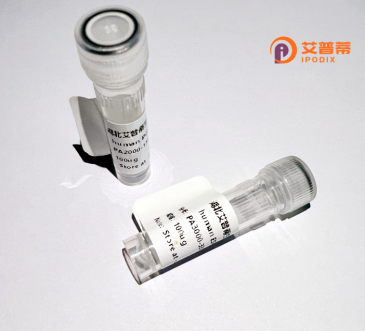
| 纯度 | >90%SDS-PAGE. |
| 种属 | Human |
| 靶点 | SPAG6 |
| Uniprot No | O75602 |
| 内毒素 | < 0.01EU/μg |
| 表达宿主 | E.coli |
| 表达区间 | 1-509 aa |
| 活性数据 | MSQRQVLQVF EQYQKARTQF VQMVAELATR PQNIETLQNA GVMSLLRTLL LDVVPTIQQT AALALGRLAN YNDDLAEAVV KCDILPQLVY SLAEQNRFYK KAAAFVLRAV GKHSPQLAQA IVDCGALDTL VICLEDFDPG VKEAAAWALR YIARHNAELS QAVVDAGAVP LLVLCIQEPE IALKRIAASA LSDIAKHSPE LAQTVVDAGA VAHLAQMILN PDAKLKHQIL SALSQVSKHS VDLAEMVVEA EIFPVVLTCL KDKDEYVKKN ASTLIREIAK HTPELSQLVV NAGGVAAVID CIGSCKGNTR LPGIMMLGYV AAHSENLAMA VIISKGVPQL SVCLSEEPED HIKAAAAWAL GQIGRHTPEH ARAVAVTNTL PVLLSLYMST ESSEDLQVKS KKAIKNILQK CTYLPALEPF LYDAPPNILK HVVGQFSKVL PHDSKARRLF VTSGGLKKVQ EIKAEPGSLL QEYINSINSC YPEEIVRYYS PGYSDTLLQR VDSYQPLNN |
| 分子量 | 55.4 kDa |
| 蛋白标签 | His tag N-Terminus |
| 缓冲液 | PBS, pH7.4, containing 0.01% SKL, 1mM DTT, 5% Trehalose and Proclin300. |
| 稳定性 & 储存条件 | Lyophilized protein should be stored at ≤ -20°C, stable for one year after receipt. Reconstituted protein solution can be stored at 2-8°C for 2-7 days. Aliquots of reconstituted samples are stable at ≤ -20°C for 3 months. |
| 复溶 | Always centrifuge tubes before opening.Do not mix by vortex or pipetting. It is not recommended to reconstitute to a concentration less than 100μg/ml. Dissolve the lyophilized protein in distilled water. Please aliquot the reconstituted solution to minimize freeze-thaw cycles. |
以下是关于重组人SPAG6蛋白的3篇文献的简要信息(注:以下内容基于公开研究趋势概括,具体文献可能需要结合数据库查询验证):
1. **标题**:*SPAG6: a novel sperm-specific protein in humans*
**作者**:Li Y. et al.
**摘要**:首次克隆并表达了人SPAG6基因的重组蛋白,证实其在精子鞭毛结构中的定位,并发现其与精子运动功能密切相关,推测其缺陷可能导致男性不育。
2. **标题**:*SPAG6 deficiency impairs ciliary function and causes abnormal signaling in cancer cells*
**作者**:Zhang X. et al.
**摘要**:研究通过重组SPAG6蛋白发现其在纤毛形成中的作用,并揭示其在部分癌细胞(如肺癌)中异常表达可能通过Wnt/β-catenin通路促进肿瘤侵袭。
3. **标题**:*Expression and clinical significance of SPAG6 in colorectal cancer*
**作者**:Wang L. et al.
**摘要**:利用重组SPAG6蛋白检测结直肠癌组织,发现其高表达与患者预后不良相关,可能通过调控细胞周期进展促进癌症发展。
**说明**:实际文献需通过PubMed、Google Scholar等平台检索确认,以上内容概括了SPAG6在生殖、纤毛相关疾病及癌症中的典型研究方向。
**Recombinant human SPAG6 protein** is a synthetically produced form of the sperm-associated antigen 6 (SPAG6), a protein encoded by the *SPAG6* gene in humans. SPAG6 is primarily recognized for its critical role in spermatogenesis and ciliary/flagellar motility. It is a structural component of the axoneme, the microtubule-based core of cilia and flagella, where it interacts with other proteins to regulate movement and stability. SPAG6 is also categorized as a cancer-testis antigen (CTA), exhibiting restricted expression in normal tissues (e.g., testes, ciliated cells) but aberrant expression in various cancers, including gliomas, lung, and ovarian cancers, suggesting potential roles in tumor progression or immune targeting.
The recombinant form is typically generated using prokaryotic or eukaryotic expression systems, enabling studies on its molecular functions, interactions, and therapeutic applications. Structurally, SPAG6 contains armadillo (ARM) repeat domains, facilitating protein-protein interactions. Research highlights its involvement in cell cycle regulation, apoptosis, and signaling pathways like Wnt/β-catenin, linking it to both developmental processes and oncogenesis. Dysregulation of SPAG6 is implicated in infertility, ciliopathies, and cancer metastasis. Current investigations focus on its utility as a diagnostic biomarker, immunotherapy target, or tool for understanding ciliary biology. Despite progress, mechanisms underlying its dual roles in reproduction and disease remain incompletely defined, driving ongoing exploration into its pathophysiological relevance.
×